
Steamboat Letterheads, page 1
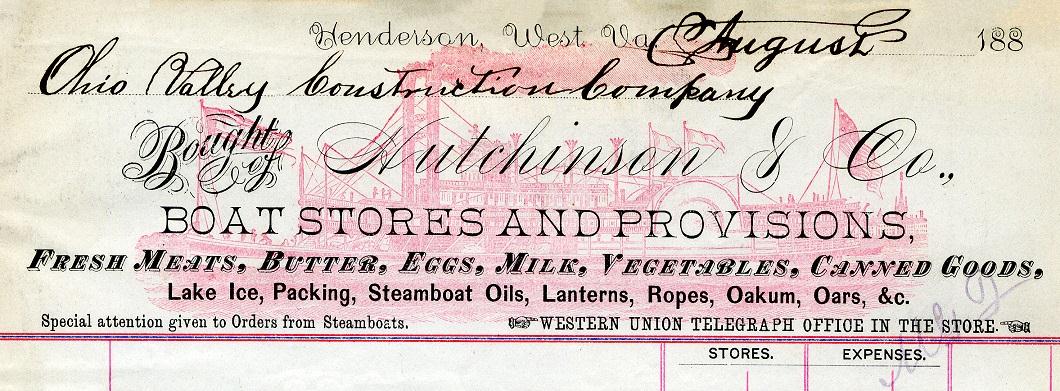
Letterhead from a receipt from Hutchinson & Co. Boat Stores & Provisions of Henderson, West Virginia to Ohio Valley Construction Company 1880's
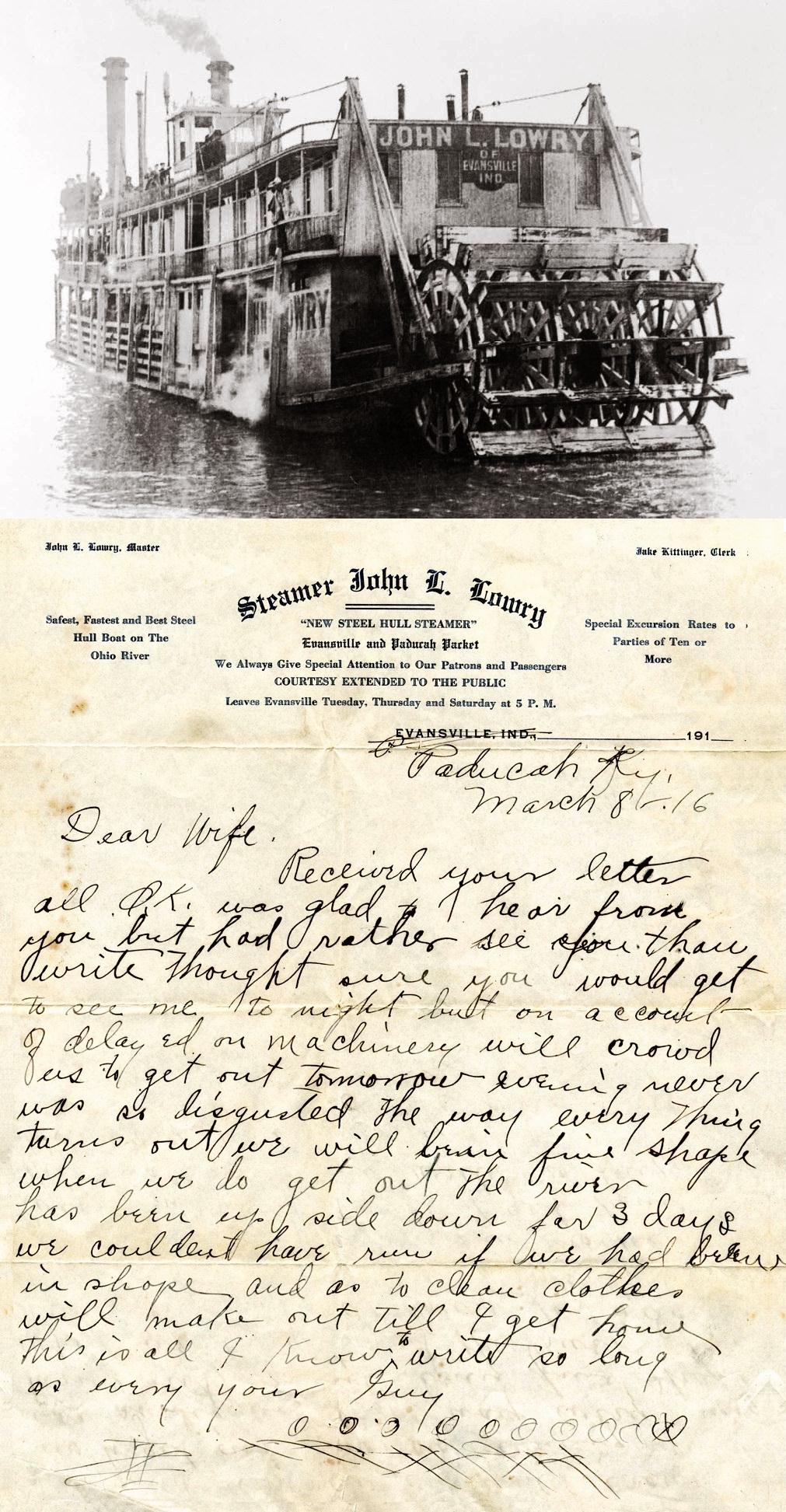
JOHN L. LOWRY letterhead and correspondence 1916
Very interesting "letter home" from passenger "Guy" to his "Dear Wife" in 1916.
Did a lot of restoring to the letter and although his penmanship was irregular and his sentences run together without punctuation there's still some charm to it.
Written on the letterhead for the Steamer JOHN L. LOWRY Paducah, Kentucky
March 8, 1916
Dear Wife.
Received your letter all O.K. was glad to hear from you but had rather see you than write thought sure you would get to see me to night but on account of delayed on machinery will crowd us to get out tomorrow evening never was so disgusted the way every thing turns out we will be in fine shape when we do get out the river has been up side down for 3 days we couldn't have run if we had not been in shape and as to clean clothes will make out till I get home this is all I know to write so long as ever your Guy
JOHN L. LOWRY
Sternwheel Packet
Way's Packet Directory Number 3085
Built in 1913 at Evansville, Indiana
Captain John L. Lowry owner and master in 1914
Captain Milt Harry also served as master
The LOWRY navigated the Ohio; Mississippi and Illinois rivers
Ran the Evansville-Paducah trade.
On March 17, 1919, she sank in a storm at Kincaide Landing, Illinois and was raised.
In 1920 she was taking coal at Saline Mines, Illinois, near Shawneetown when she burned on October 4th.
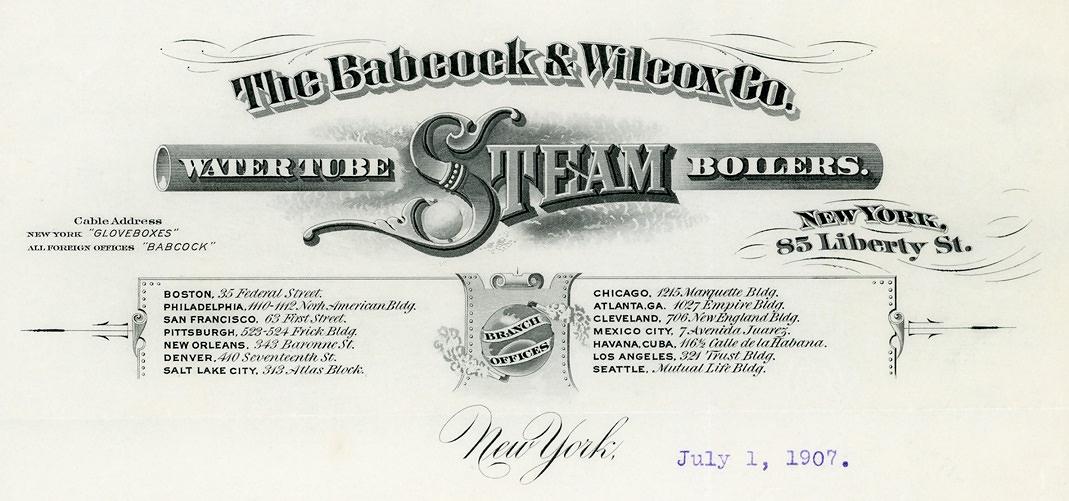
Babcock & Wilcox watertube STEAM boilers letterhead 1907
Babcock & Wilcox Watertube Steam Boilers letterhead from 1907 Main office in New York City with branch offices in the river cities of Pittsburgh, PA and New Orleans, LA who would have provided boilers for steamboats on Inland Waterways on the Ohio & Mississippi rivers.
Jim Hale wrote us about the preference for watertube boilers in an e-mail in which he advised on a technical question about boilers from one of your correspondents a while back.
"Their ability to work at higher pressures has led to marine boilers being almost entirely water-tube."
From Wikipedia, the free encyclopedia:
A watertube boiler (also spelled water-tube and water tube) is a type of boiler in which water circulates in tubes heated externally by the fire. Fuel is burned inside the furnace, creating hot gas which heats water in the steam-generating tubes. In smaller boilers, additional generating tubes are separate in the furnace, while larger utility boilers rely on the water-filled tubes that make up the walls of the furnace to generate steam. The heated water then rises into the steam drum. Here, saturated steam is drawn off the top of the drum. In some services, the steam will reenter the furnace through a superheater to become superheated. Superheated steam is defined as steam that is heated above the boiling point at a given pressure. Superheated steam is a dry gas and therefore used to drive turbines, since water droplets can severely damage turbine blades. Cool water at the bottom of the steam drum returns to the feedwater drum via large-bore 'downcomer tubes', where it pre-heats the feedwater supply. (In large utility boilers, the feedwater is supplied to the steam drum and the downcomers supply water to the bottom of the waterwalls). To increase economy of the boiler, exhaust gases are also used to pre-heat the air blown into the furnace and warm the feedwater supply. Such watertube boilers in thermal power stations are also called steam generating units. The older fire-tube boiler design, in which the water surrounds the heat source and gases from combustion pass through tubes within the water space, is a much weaker structure and is rarely used for pressures above (350 pound per square inch). A significant advantage of the watertube boiler is that there is less chance of a catastrophic failure: there is not a large volume of water in the boiler nor are there large mechanical elements subject to failure. A water tube boiler was patented by Blakey of England in 1766 and was made by Dallery of France in 1780. Marine Their ability to work at higher pressures has led to marine boilers being almost entirely water-tube. This change began around 1900, and traced the adoption of turbines for propulsion rather than reciprocating (i.e. piston) engines - although watertube boilers were also used with reciprocating engines.
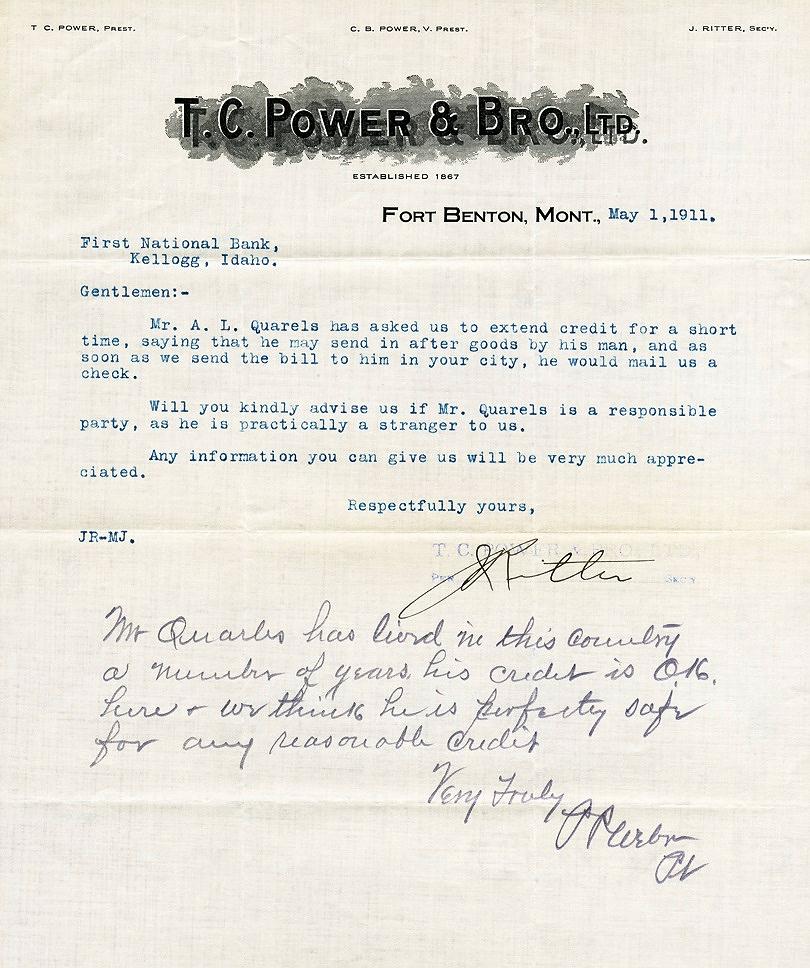
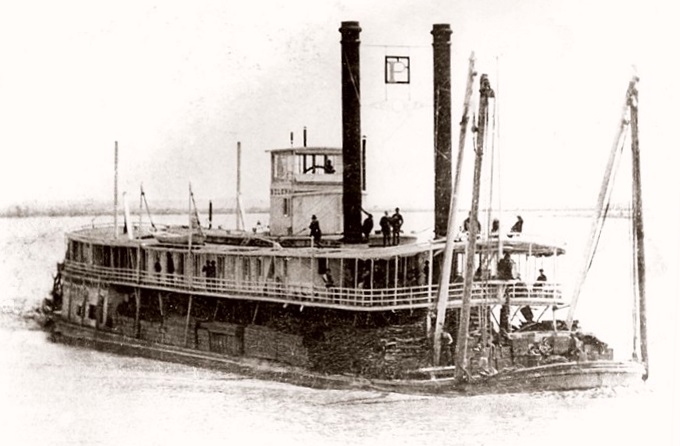 Letterhead T.C. Power was the president of a steamboat line, owning and operating 9 steamers on the Missouri River
Letterhead T.C. Power was the president of a steamboat line, owning and operating 9 steamers on the Missouri River
Letterhead 1 May, 1911 T.C. Power & Bro Ltd. at Fort Benton, Montana on the Missouri River. Power was president of a steamboat line, that owned and operated 9 steamers on the Missouri.
The Steamboat Helena of the "Block P" T. C. Power Line, circa 1885.
Photo from the Cincinnati Public Library
helenahistory.org
Note the "Block P" trademark between the stacks. The steamboat Helena, a sternwheel packet with a wood hull, was built in California, Pennsylvania in 1878. In 10 years she made over 50 trips to Montana points under many masters associated with the Power Line. She was sold in 1887 to A.S. Bryan and others, Washington, Missouri. The Helena was snagged and destroyed at Bonhomme Island, Missouri, Oct. 23, 1891.
T.C. Power & Bro, magnates of the American Frontier
June 21, 2016
powerclangathering.com
Thomas C. Power
"T. C. Power and Bro" was a prominent mercantile business started by Thomas Charles Power (1839-1923) and his brother John (1844-1901), who were to become well established traders in Montana and across several southern Canadian provinces.
Of Iowa and Pennsylvania Irish Catholic stock, their parents Michael Power and Catherine McLeer arrived in Iowa, via Missouri in the 1830s. Their father Michael, himself an established mercantile man, had came to the United States from Ireland as a young emigrant.
In 1867, Tom C. Power, having completed his private schooling in Sinsinawa, Wisconsin, travelled up the Missouri River to Fort Benton, Montana and opened a general mercantile store, in partnership with his brother. During the years of the U.S. Civil War, the Powers were involved in trade along the mighty Missouri River, primarily dealing with steamboats. T.C. Power eventually became president of a steamboat line, at one time owning and operating 9 steamers.
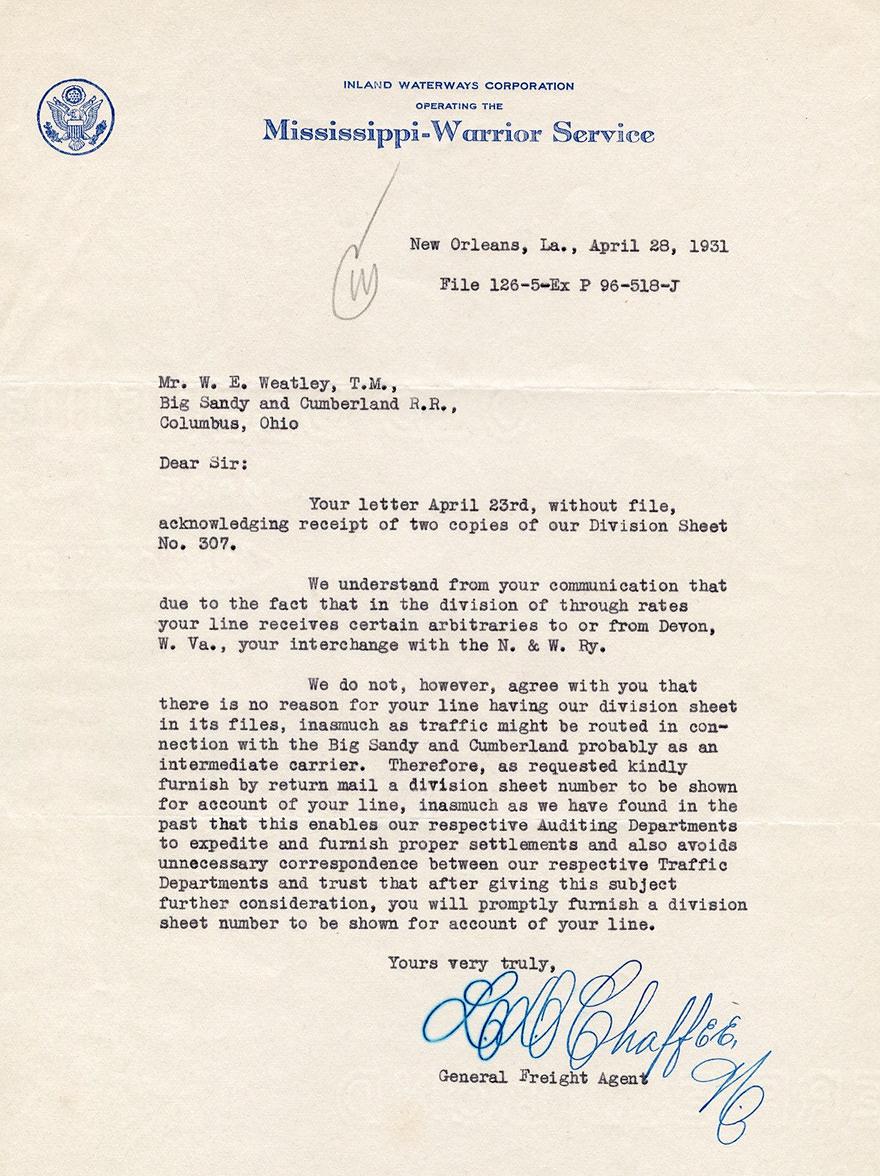
INLAND WATERWAYS CORPORATION operating the MISSISSIPPI-WARRIOR RIVER Service
Letterhead with typewritten 1931 correspondence from:
INLAND WATERWAYS CORPORATION
operating the
MISSISSIPPI-WARRIOR RIVER Service
New Orleans, Louisiana dated 28 April 1931
from L.D. Chaffee
Gen'l Freight Agent
to W.E. Weatley
Big Sandy and Cumberland RR in Columbus, Ohio
This was a follow up to a letter to W.A. Weaklin of the BIG SANDY & CUMBERLAND RR that was also from L.D. Chaffee and dated 16 April, 1931 but with a different letterhead:
INLAND WATERWAYS CORPORATION
operating the
FEDERAL BARGE LINES Service
(Formerly MISSISSIPPI-WARRIOR Service)
This apparently involved a dispute or misunderstanding between Weatley (whose name may have been deliberately misspelled "Weaklin" (which may have been taken as an insult implying that Weatley was somehow considered to be a "Weakling."
The text of the letter above gives some idea of the controversy which originated with some disagreement over an expected response to a "General letter" from the Southern Freight Association dated 1 April, 1931. Which could have somehow been misunderstood as an "April Fool's Joke"(?)
I have not found a reference to a Warrior River but have found the Black Warrior River:
"The Black Warrior River is a waterway in west-central Alabama in the southeastern United States. The river rises in the extreme southern edges of the Appalachian Highlands and flows 178 miles to the Tombigbee River, of which the Black Warrior is the primary tributary." wikipedia
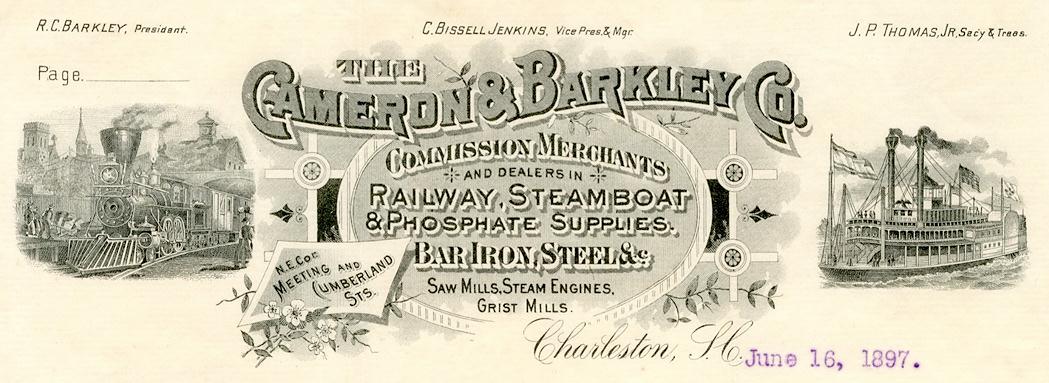
Exceptional 1875 pass for the Evansville, Cairo & Memphis Steam Packet Co. that also had an had office Paducah, Kentucky. They operated the steamboats ARKANSAS BELLE, the IDLEWILD and the QUICK STEP. There are many pieces of very early sheet music which had the subheading Quick Step (a fast paced step in "social dancing") including the STEAMBOAT QUICK STEP which sounds like an Irish jig.
The term was revived and compressed into one word: the Quickstep in the 1920's as a fast paced dance step to accompany ragtime and jazz numbers which became a musical "craze" in those days.
Love that name "Quick Step" for a steamboat. Reminds me of the ancient Greek "Terpsichore" which is synonymous with "delight in dancing." Terpichore was the goddess of dance and chorus - one of the nine female muses in Greek mythology.
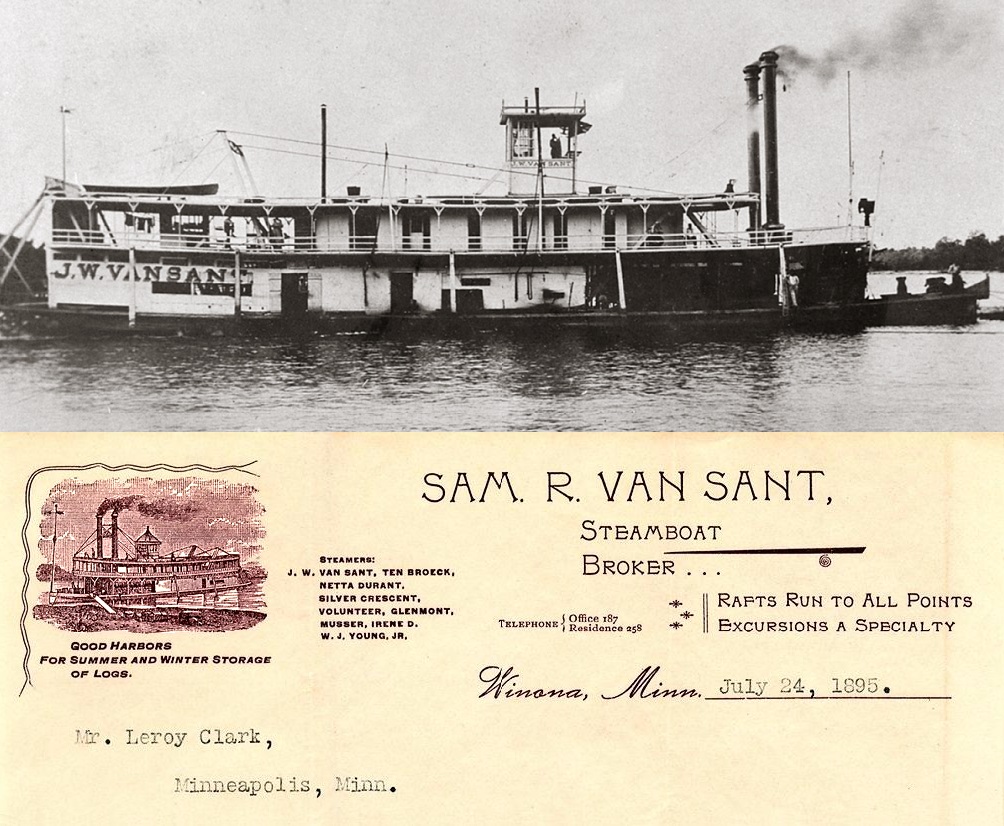
Steamboat broker Sam R. Van Sant's letterhead dated July 24th, 1895
Fred Way's biography and a photo of the J.W. VAN SANT, the first of the nine steamboats listed on the letterhead:
J.W. VAN SANT
Sternwheel Rafter, 1869-1878
Way's Towboat Directory Number T1310
Built at Le Claire, Iowa, 1869
Owners:
In 1869: J.W. Van Sant & Son
In 1872: Eau Claire Lumber Company
Officers & Crew:
Captain George Winans; 1872
Daniel Drison (pilot)
Henry Whitmore (engineer)
The J.W. VAN SANT was built to be capable of lowering her stacks and pilothouse to follow her rafts under the Rock Island bridge.
Frederick Weyerhaeuser of Rock Island, Illinois was a passenger on her first trip.
Her first tow was for the Weyerhaeuser and Denkmann sawmill from Cat Tail Slough to Rock Island.
Dismantled, 1878.
The other 8 Van Sant steamboats listed on the letterhead are:
Ten Broeck
Netta Durant
Silver Crescent
Volunteer
Glenmont
Musser
Irene D.
W.J. Young, Jr.
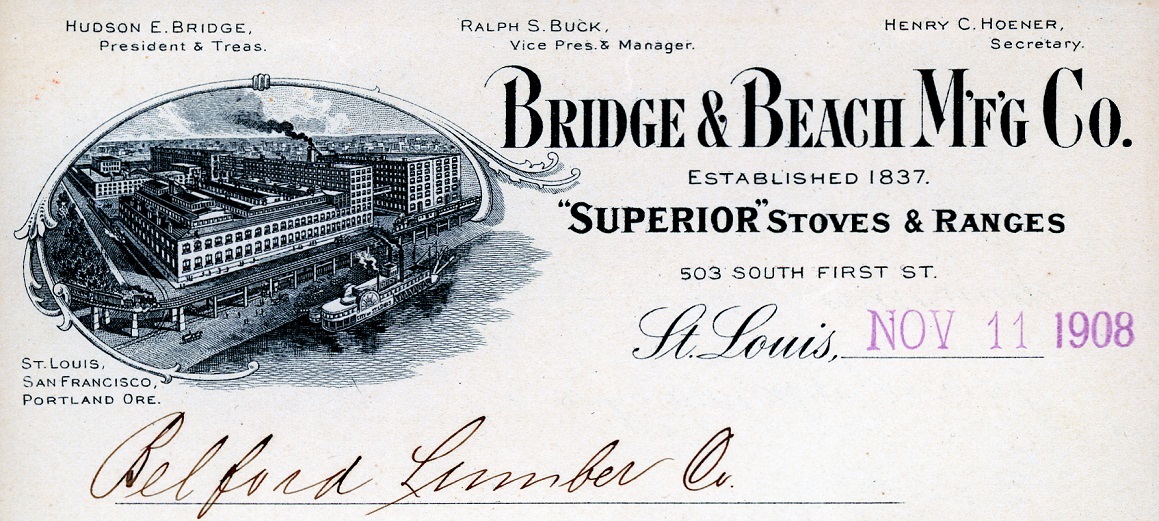
Letterhead with engraving of riverside factory and steamboat CITY OF ST. LOUIS 1908 at the landing, Bridge & Beach Co.
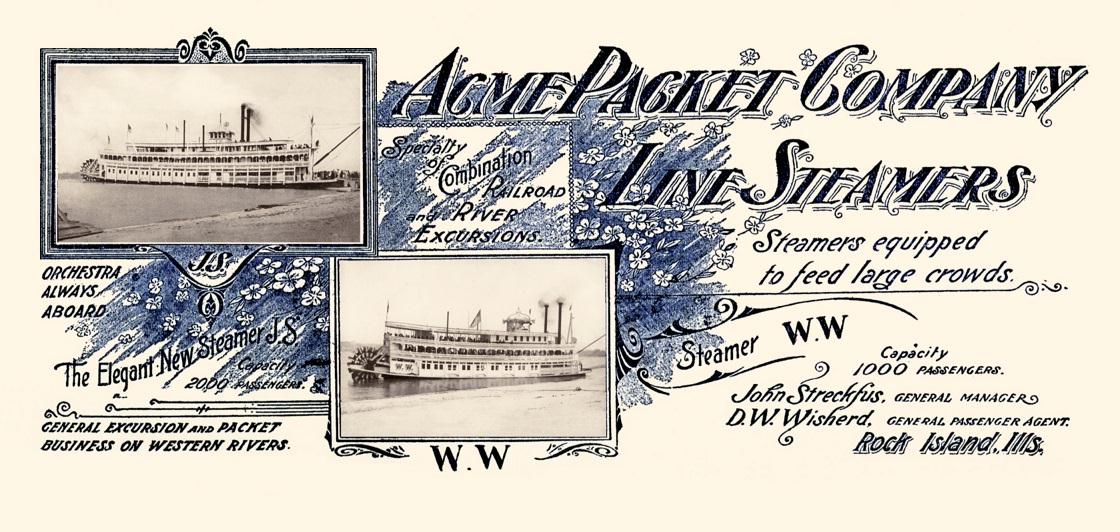
Acme Packet Co. Line Steamers Letterhead date April 6, 1910 with steamboats J.S. (JOHN STRECKFUS) and W.W. (Walter Wishered) featured in photo graphics.
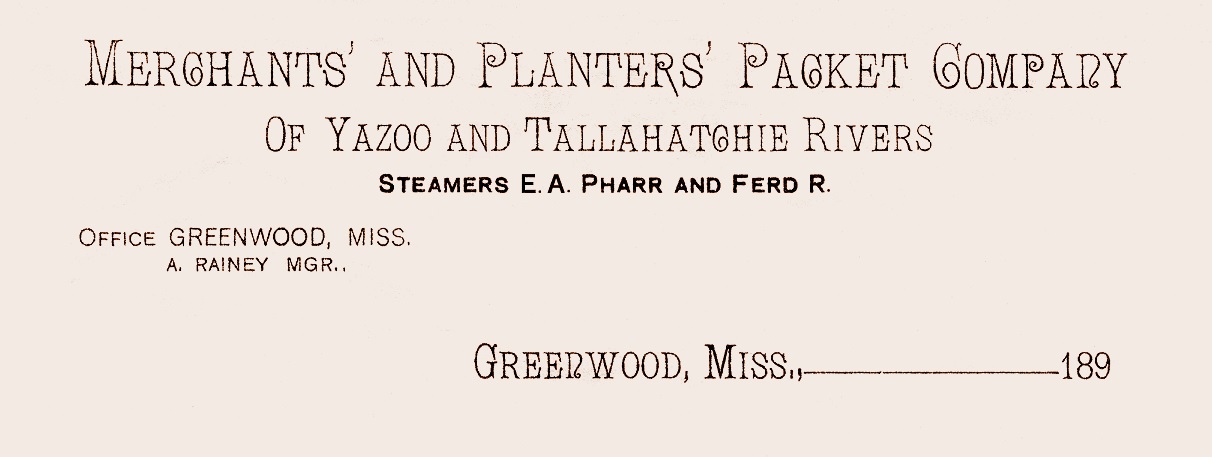
Merchants and Planters Packet Co. - Greenwood, Mississippi
Above 1890's letterhead for the Merchants' & Planters' Packet Co. of Greenwood, Mississippi restored from the upper portion of a dilapidated 5.90 x 9.50 inch original.
E.A. PHARR
Sternwheel packet boat
Way's Packet Directory Number 1638
Built at Patterson, Louisiana in 1892
Documented at Vicksburg, Mississippi in 1896
FERD R.
a Sternwheeler not listed in Way's Directory
However, both of these boats are mentioned in the following, quoted from page 159 of Steamboats & the Cotton Economy - River Trade in the Yazoo-Mississippi Delta by Harry P. Owens ~ University Press of Mississippi 1990:
"W.F. Ramay built the sternwheel steamer FERD R. at Greenwood in 1892 and entered the trade. The next year the new boat hit a snag and was towed to Captain Pugh's boatyard at Yazoo City. She was originally only 70 feet long, but when rebuilt she measured 93.8 x 16.2 x 3 feet. When the FRED R. returned to the Yazoo trade, she was owned by W.C. George, who had started the Greenwood Transportation Company. Within a few month, the Greenwood firm purchased the sixty three ton sternwheeler E.A. PHARR to serve upper river shippers."
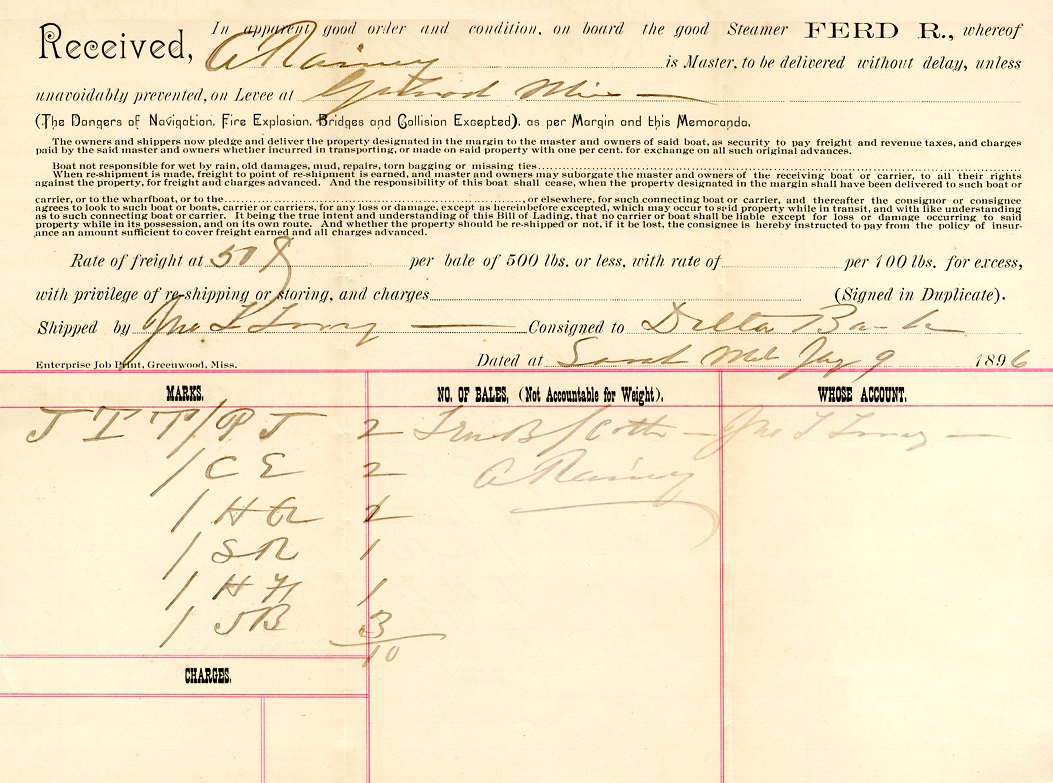
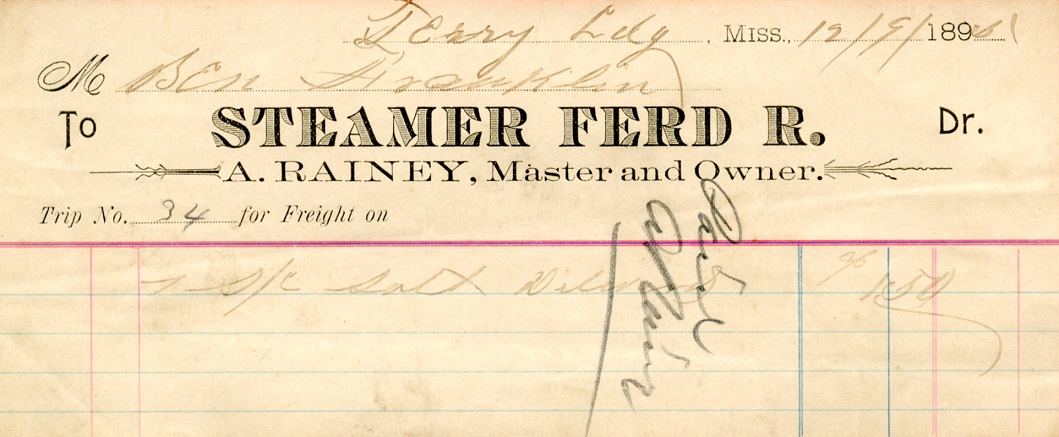
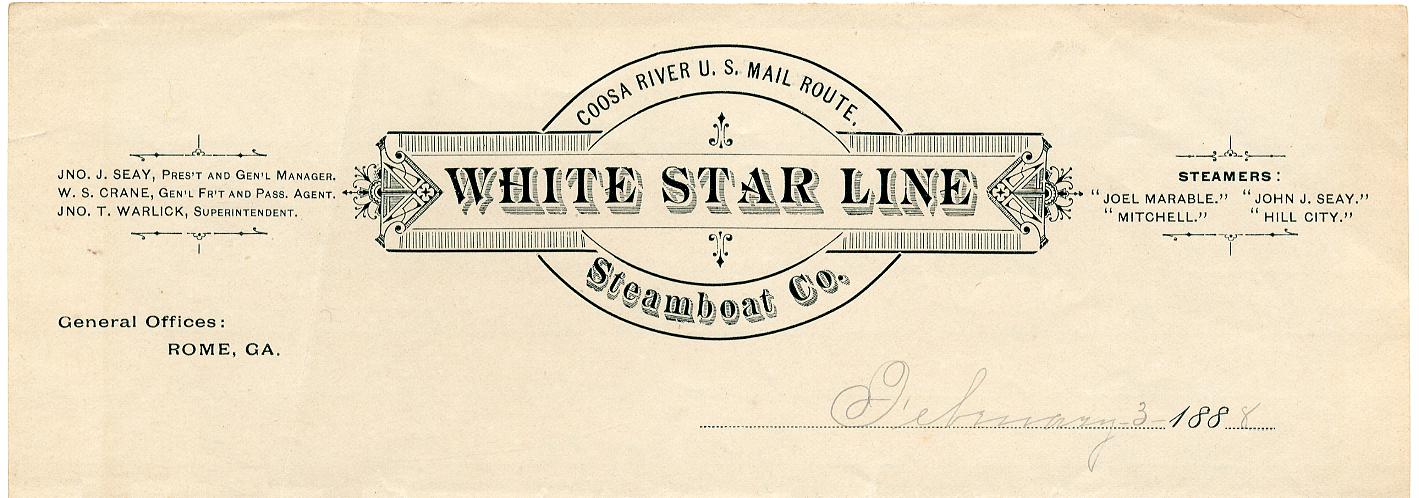
This just in, letterhead for the WHITE STAR LINE Steamboat Co. which ran on the Coosa River with headquarters in Rome, Georgia. The Coosa River's headwaters are in northeast at Rome, Georgia at the confluence of the Oostanaula and Etowah rivers. Most of the length of the Coosa runs diagonally from northeast to southwest in the upper right quadrant of the state of Alabama.
The following is from Wikipedia:
The Coosa River played an important role into the early 20th century as a commercial waterway for riverboats along the upper section of the river for 200 miles south of Rome. However, shoals and waterfalls such the Devil's Staircase along the river's lowest 65 miles blocked the upper Coosa's riverboats from access to the Alabama River and the Gulf of Mexico.
The following information is from the act of incorporation by the Georgia Legislature (provided by Dennis Nordeman, author of a book about Coosa River Steamboats):
Information about the incorporation of the White Star Line is included below.
Following the model of the Red Line Steamboat Company, John J Seay and T.V Marable used the steamer Joel Marable as the capital to form their new company that was incorporated September 21, 1883. The Joel Marable was valued at $10,000 ($260,000 in 2020). Future expansion up to $100,000 was provided for by allowing stock sales at $25 per share ($650 in 2020).
The company was organized
"for the purpose of owning, building, purchasing, equipping, employing or chartering and fitting out steamboats to be propelled by steam, and to be run and employed in navigation and the transportation of freight and passengers over the waters of the Coosa river, and over all navigable streams flowing into, forming or tributary thereto, and all the powers, privileges and immunities necessary or beneficial to such a corporation, are hereby granted and conferred upon the same, and especially the power to charge and collect freights, tariffs and passenger fares, and to purchase, own or sell wharves, warehouses, real estate and all other property that will tend to facilitate the accomplishment of the purpose for which said White Star Line Steamboat Company is created".
In addition to the Marable, this company built the John J Seay and the Clifford B Seay.

With the exception of images credited to public institutions,
everything on this page is from a private collection.
Please contact Steamboats.com for permission for commercial use.*
All captions provided by Dave Thomson, Steamboats.com primary contributor and historian.
